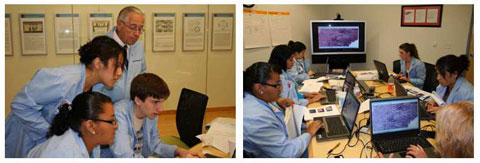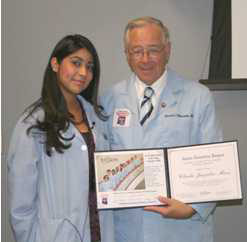
High school students taking medical school courses? Do we need a radical over-haul of pre-medical education? Can the sacred cows, the current pre-medical college course requirements for medical school admission, be put out to pasture? National authorities on training doctors are beginning to get restless over this issue. The T-Health Institute, located in Phoenix, Arizona, is asking some key questions and actually putting them to the test.
In June 2008, the T-Health Institute began examining the admission requirements of medical schools by doing an experiment. “We went back to the basics. We wanted to see if our high school students, without the benefit of medical school prerequisite courses, could actually handle medical school-type courses,” says Ronald S. Weinstein, M.D., Founding Director of the national award-winning Arizona Telemedicine Program, the parent organization of T-Health Institute. “Even the premise that current prerequisite courses for medical school admission should come first, before medical school, should be open to question. We think that the time has come to think outside of the box, and we are doing it at T-Health”, he states.
Currently, many medical schools require a long list of premedical science courses before students are even considered for admission. Typical requirements are —1 year of biology, 2 years of chemistry, 1 year of physics, and sometimes even 1 year of mathematics—before students are considered for admission. This narrows the applicant pool. Staying in college long enough to fulfill the requirements can result in students racking up debt. “We could graduate medical students more quickly, helping to fill the gap of needed healthcare professionals if they do not have to go though 8 years of undergraduate and medical schooling,” notes Gail P. Barker, Ph.D., Director of the T-Health Institute in Phoenix.
Medical school admission requirements are an important issue for the Arizona Telemedicine Program, which has support from the state to bring healthcare services to rural communities with shortages of healthcare professionals. “The issues are complicated. However, we needed to see if we can streamline the education of future rural practitioners,” said Weinstein. “Something needs to be done to reduce the years of training and expense of getting a medical education if we are going to address a number of rural health issues. Access to healthcare is a critical issue for some of our rural Arizona communities,” he added.
The T-Health Institute invited Phoenix high school students as young as 16 years of age to participate in a study. Jose E. Nanéz, Ph.D., Executive Director, Community Outreach, at Arizona State University, nominated some of the high school students. Some of the students had little, if any, prior exposure to biology or chemistry courses in high school. They were admitted into the T-Health Institute’s Sir William Osler High School Summer Fellowship Program based on grades and personal interviews.
Over a six week period, the high school Osler Fellows studied the nature of disease, including topics normally reserved for first and second year medical students and unavailable at Arizona undergraduate colleges. Experienced medical school faculty members enthusiastically volunteered to teach the course.
“Being part of this innovative medical education program was really a highlight of my summer,” stated Ana Maria Lopez, M.D., M.P.H., Associate Dean for Outreach and Multicultural Affairs at the University of Arizona College of Medicine and Associate Professor of Clinical Medicine and Pathology. Dr. Lopez spoke with the students via the Arizona Telemedicine Program network, of which she is the founding Medical Director. She observed. “Not only were the students bright and interested, they were willing to go the extra mile to be independent learners!”
The classes were designed to simulate medical school classes and laboratories. None of the students had prior experience with histopathology (the examination of diseased tissues through light microscopes). They examined normal and diseased tissues using “virtual slides” on computers, a state-of-the-art education technology implemented at the University of Arizona College of Medicine last year.
The faculty members then assessed the students’ knowledge of the subject. To everyone’s delight, the high school students performed as well as medical students.
The last day of the six week program, the high school students gave individual presentations on specific diseases they had studied, such as multi-drug resistant tuberculosis and brain cancer. The medical school faculty members who participated in the program “were very impressed with the students’ presentations, as well as with their performances on written exams,” according to Anna R. Graham, M.D. a faculty member for the T-Health Institute’s summer high school program and also a Life Time Educator Award winner at the University of Arizona. Dr. Graham is past-president of the American Society for Clinical Pathology, one of the largest pathology professional associations in the nation, and a professor of pathology. “To us, the high school student performances were equal to what our medical students can do with this course material. We are eager to follow up on these observations next summer,” Graham added.
“The medical education community has underestimated the capabilities of high school students to understand disease processes,” says Margaret Briehl, Ph.D., an Associate Professor of Pathology at the University of Arizona and cancer researcher who taught in the program. “Our faculty members were genuinely inspired by these high school students’ performances!” she said and added, “The Osler Program could shed light on how we should be educating doctors for the twenty-first century. The process might be streamlined, shortening the length of time it takes to get the M.D. degree in Arizona.”
Strengthening the high school system in the United States to the equivalent of an international baccalaureate experience, as it exists in high schools in other countries, would facilitate the entry of United States students into a more rigorous college curriculum. The United States is one of the few countries in the world where the baccalaureate is awarded after an additional 4 years post high school.
The idea that all of the current prerequisite courses are necessary for students to perform well in medical school was not seriously challenged in the U.S.--until recently-- when authorities in the field of medical education began to raise questions about the requirements for admission to medical schools. Arizona is ahead of the curve in tackling the issue.
T-Health’s high school program was named in honor of Sir William Osler, in honor of a legendary innovator in healthcare education. Osler was a famous physician who created our basic medical school curriculum model over a century ago. He was Professor of Medicine at Johns Hopkins Medical School in Baltimore, Maryland. Osler wrote an important textbook on medicine, in 1892, and became a household name by the turn of the last century. He was also the great poet Walt Whitman’s doctor and a close friend of Mark Twain for many years. “Osler might have been delighted to know how this summer’s experiment in medical education turned out,” according to Weinstein. “He had great confidence in young people’s abilities. Nothing that keen students accomplish would have surprised Osler.”
Weinstein notes, “We’ve only scratched the surface on our healthcare education research, but this summer’s experiences are interesting and thought-provoking. We’re beginning to think that the study of the nature of disease (i.e., etiology, pathology and pathophysiology, ect.) should be offered in the first year of college. Then, the other college courses for future healthcare professionals would be taught to students who already have a basis understanding of disease processes. Learning about healthcare and prevention would become life-long, not an add-on at medical school. As far as I’m concerned, understanding basis disease processes should be part of almost any general education in the twenty-first century”, he added. “We can teach that to any interested college student,” he added.
The T-Health Institute’s experiment could have even broader implications. “People must begin to take responsibility for their own health, and that should start in college or before”, Weinstein states with conviction. “Accelerating the introduction of courses on the nature of diseases would help”. He adds, “demystifying the practice of medicine for the lay public, through the sharing of ‘medical secrets’, might help reduce medical errors in the United States.”
Gail P. Barker, Ph.D, said, “Next summer, we plan to bring slices of medical school courses to a larger number of Arizona high school students and extend the program to Tucson. Hopefully, students will be able to make career choices earlier than before.”
Information: Sir William Osler High School Summer Fellowships (pdf)
